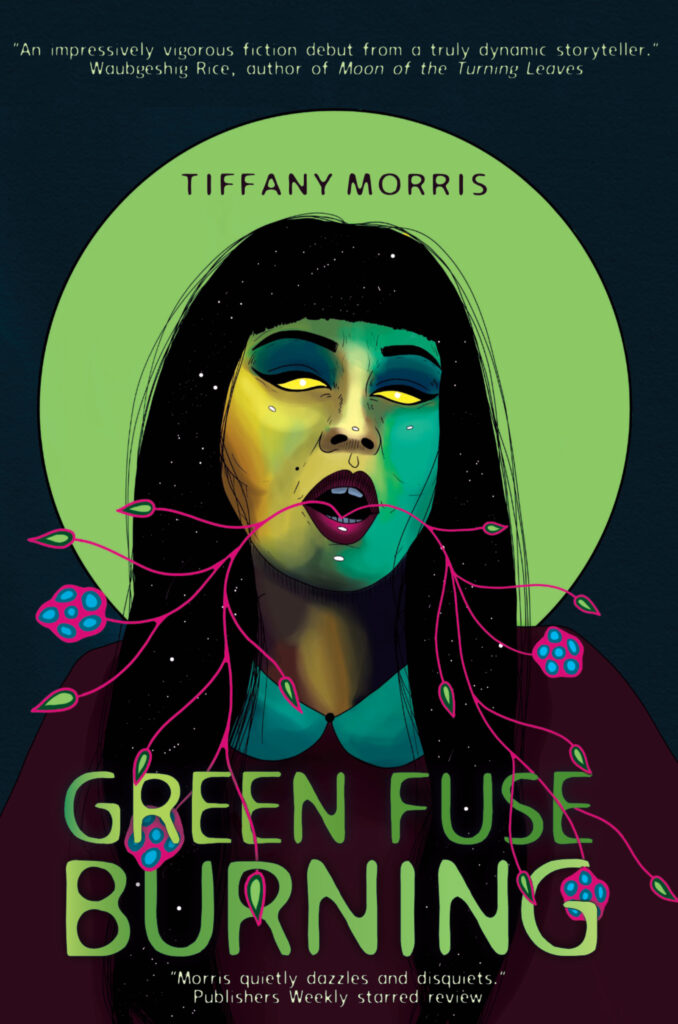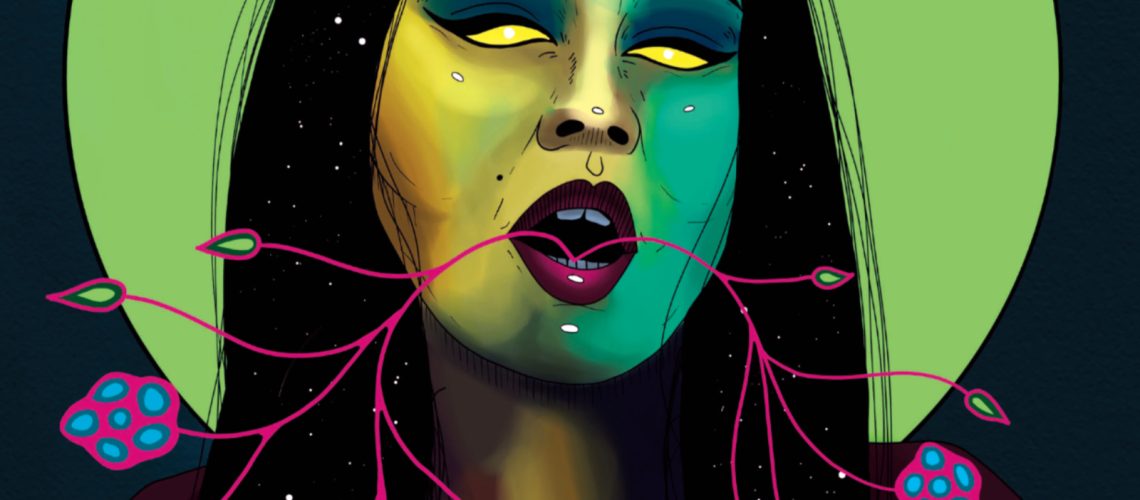The title of indigenous author Tiffany Morris’ new eco-horror novella from Stelliform Press comes from the opening lines of “The force that through the green fuse drives the flower” by Welsh poet Dylan Thomas, which Morris includes as one of the epigraphs that precede the story:
The force that through the green fuse drives the flower
Drives my green age; that blasts the roots of trees
Is my destroyer
– Dylan Thomas
In Green Fuse Burning, Morris takes Thomas’ theme of the intertwined nature of life and death in an endless cycle of time and applies it through a spectrum of ecosystems from the grandiose to the individual to explore the psychology of grief and guilt both personal and collective. Or as she succinctly summarizes within the novella: “Grief, like life, was green.”
Tiffany Morris, an L’nu’skw (Mi’kmaw)/settler writer of speculative fiction and poetry, from Kjipuktuk (Halifax), Nova Scotia, has had work published in Apex, Nightmare, and Uncanny magazines, and her horror poetry collection Elegies of Rotting Stars (Nictitating Books, 2022) was nominated for an Elgin Award. Her new novella from Stelliform Press continues to demonstrate her talents at writing entertaining and perceptive horror that incorporates multiple complex ideas into a tightly-packaged, inventive form.

Morris structures Green Fuse Burning to relate her theme of creation/destruction both in the literal sense and within the figurative concept of artistic endeavors. The story is organized as a curated presentation entitled Devastation of Light: The Recovered Paintings of Rita Francis that explores six multimedia paintings created by the protagonist artist while staying at an isolated cabin retreat from which she disappeared.
“In these paintings we see the murky, urgent depths of a woman’s spiritual journey into swamplands of uncertainty.”
Six sections present the catalog’s description and interpretation of Rita’s work, each followed by the story proper of the novella that recounts the strange, haunting occurrences that befall Rita within the swamps surrounding the cabin, as well as the shaky relationship with her girlfriend that has led up to her coming to the cabin. The reader discovers how events relate to the theme of each painting, and a final seventh section of story draws things completely together.
Through this Morris explores how grief and trauma may lead to an appreciation for the connections between life and death, a realization and acceptance of mortality and the beautiful possibilities of recreation. Notably, Rita at times follows thoughts around these concepts down routes of suicidal ideation, before coming to conclusions that an acceptance or welcoming of death is not the same as an active, immediate pursuit of it. Instead, Rita comes to an understanding that any such desire would be a rejection and rebellion against the unity between creation, destruction, and rebirth.
Rita explores grief at the personal level of her relationships with friends and family, the level of her ancestors and settler history, and the broadly biological ecology of human-driven climate devastation of Earth’s ecosystems. She makes symbolic connections between these different levels of grief, and how they stem from similar manifestations of trauma:
“Grief formed her new reality, her new understanding of time, an invading force that occupied land and bodies in equal measure.
Her memories were colonized by trauma.”
Morris also ties such grief and trauma into the emotion of guilt. Guilt over Rita’s estrangement from others, over her loss of ancestral culture, and over the disconnect between humanity and the rest of biology. One moment this comes out is when she goes out of the cabin to try to make sense of strange things she’s hearing and seeing to try to find some type of guidance or answer. She sees a raven and thinks about the connection to animals her Mik’kmaq family always spoke of:
She’d long wished she could encounter a spirit. Even when she was trying to escape the rez’s mangy bunnies, she wished that one of them would reveal itself as something more…
“Hello,” she said to the raven. Its black eye and its white eye searched her face. It blinked and both eyes flashed white. “Kwe’,” she said, greeting it in Mik’kmaq.
A chorus of crows cawed from somewhere far away. Rita imagined she could hear wings fluttering, the soft crackle of landing on too-dry branches. The raven threw back its head and let loose another guttural croak that echoed over still water, an otherworldly sound that felt equal parts warning and pronouncement… Rita tensed with the awareness of a prey animal on alert.
“Meskeyi”, she apologized, as if she had offended the raven with her presence. Maybe she had. The growling call made her feel as if she didn’t belong there, that the animals themselves considered her an intruder at the pond, in nature itself, their screeches an omen that couldn’t be fully articulated… Creatures that recognized her as something separate from them and from other humans, some orphaned scrap of life that didn’t fully belong to her family. She was such a terrible auntie and daughter and sister, had neglected her distant family in favor of her art, of creating her own life as if she wasn’t part of something bigger.
For fans of horror and rich descriptions of creepy terror and oozy biological viscera, Green Fuse Burning should not disappoint. Morris employs the fluids of algae and plants and fungi, or super-organisms like lichen to form monsters that threaten Rita and symbolize that biological circle of life and decay. Like an artistic endeavor itself, Rita works through her harrowing experiences of destruction to create something amazing and new for herself, and Morris demonstrates in these ways how grief can be worked through – not to be forgotten or removed – but to fuel the birth of something new.







